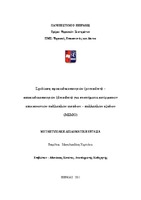Σχεδίαση προκωδικοποιητών (precoders) - αποκωδικοποιητών (decoders) για συστήματα ασύρματων επικοινωνιών πολλαπλών εισόδων - πολλαπλών εξόδων (MIMO)

Master Thesis
Συγγραφέας
Μανωλιουδάκη, Χαρίκλεια Ι.
Ημερομηνία
2012-10-29Επιβλέπων
Κανάτας, ΑθανάσιοςΠροβολή/
Θεματική επικεφαλίδα
MIMO systems ; Wireless communication systemsΠερίληψη
Η χρήση πολλαπλών κεραιών τόσο στον πομπό όσο και στον δέκτη σε ασύρματα συστήματα, γνωστή και ως τεχνολογία ΜΙΜΟ (Multiple Input - Multiple Output), είχε καθιερωθεί τις τελευταίες δεκαετίες αφού τα οφέλη από τη χρήση τους είναι πολλά. Τα συστήματα ΜΙΜΟ δίνουν τη δυνατότητα αύξησης του ρυθμού μετάδοσης γραμμικά σύμφωνα με τον ελάχιστο αριθμό κεραιών (σε πομπό και δέκτη). Επιπλέον, οι τεχνικές ΜΙΜΟ ενισχύουν την αξιοπιστία στη σύνδεση και βελτιώνουν την κάλυψη. Τα συστήματα ΜΙΜΟ εισέρχονται στην επόμενη γενιά κινητής τηλεφωνίας και ασύρματων προϊόντων LAN με την υπόσχεση ότι θα υιοθετηθούν στο προσεχές μέλλον. Για να μπορέσουμε να χρησιμοποιήσουμε τα οφέλη των συστημάτων ΜΙΜΟ, πρέπει ο δέκτης να γνωρίζει το κανάλι επικοινωνίας ή ακόμα καλύτερα αυτό μπορεί να ενισχυθεί όταν και ο πομπός γνωρίζει το κανάλι. Η αξία της γνώσης του καναλιού μετάδοσης είναι πολύ σημαντική. Για παράδειγμα, σε ένα σύστημα με τέσσερις μμ κεραίες στον πομπό και δυο κεραίες στον δέκτη και με ανεξάρτητο και ταυτόσημα κατανεμημένο (iid- independent identically distributed) Rayleigh κανάλι με επίπεδες διαλείψεις (flat-fading), η γνώση του καναλιού μετάδοσης μπορεί να διπλασιάσει τη χωρητικότητα του καναλιού για σηματοθορυβικό λόγο 5dB και να προσθέσει ακόμα 1,5b/s/Hz στα 5dB SNR. Αυτό το εύρος τιμών SNR είναι συνηθισμένο σε πρακτικά συστήματα, όπως οι εφαρμογές Wi-Fi και WiMax. Σε ένα κανάλι που δεν είναι ανεξάρτητο και ταυτόσημα κατανεμημένο, η γνώση του καναλιού στον πομπό προσφέρει ακόμη μεγαλύτερη απόδοση. Η αξιοποίηση της πληροφορίας όταν το κανάλι είναι γνωστό στον πομπό (CSIT - Channel State Information at the Transmitter) έχει μεγάλο πρακτικό ενδιαφέρον για τα ασύρματα συστήματα ΜΙΜΟ.


